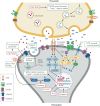The role of neurotrophic factors in novel, rapid psychiatric treatments
- PMID: 37673965
- PMCID: PMC10700398
- DOI: 10.1038/s41386-023-01717-x
The role of neurotrophic factors in novel, rapid psychiatric treatments
Abstract
Neurotrophic factors are a family of growth factors that modulate cellular growth, survival, and differentiation. For many decades, it has been generally believed that a lack of neurotrophic support led to the decreased neuronal synaptic plasticity, death, and loss of non-neuronal supportive cells seen in neuropsychiatric disorders. Traditional psychiatric medications that lead to immediate increases in neurotransmitter levels at the synapse have been shown also to elevate synaptic neurotrophic levels over weeks, correlating with the time course of the therapeutic effects of these drugs. Recent advances in psychiatric treatments, such as ketamine and psychedelics, have shown a much faster onset of therapeutic effects (within minutes to hours). They have also been shown to lead to a rapid release of neurotrophins into the synapse. This has spurred a significant shift in understanding the role of neurotrophins and how the receptor tyrosine kinases that bind neurotrophins may work in concert with other signaling systems. In this review, this renewed understanding of synaptic receptor signaling interactions and the clinical implications of this mechanistic insight will be discussed within the larger context of the well-established roles of neurotrophic factors in psychiatric disorders and treatments.
© 2023. The Author(s), under exclusive licence to American College of Neuropsychopharmacology.
Conflict of interest statement
The authors declare no competing interests.
Figures

References
Publication types
MeSH terms
Substances
Grants and funding
LinkOut - more resources
Full Text Sources
Medical

